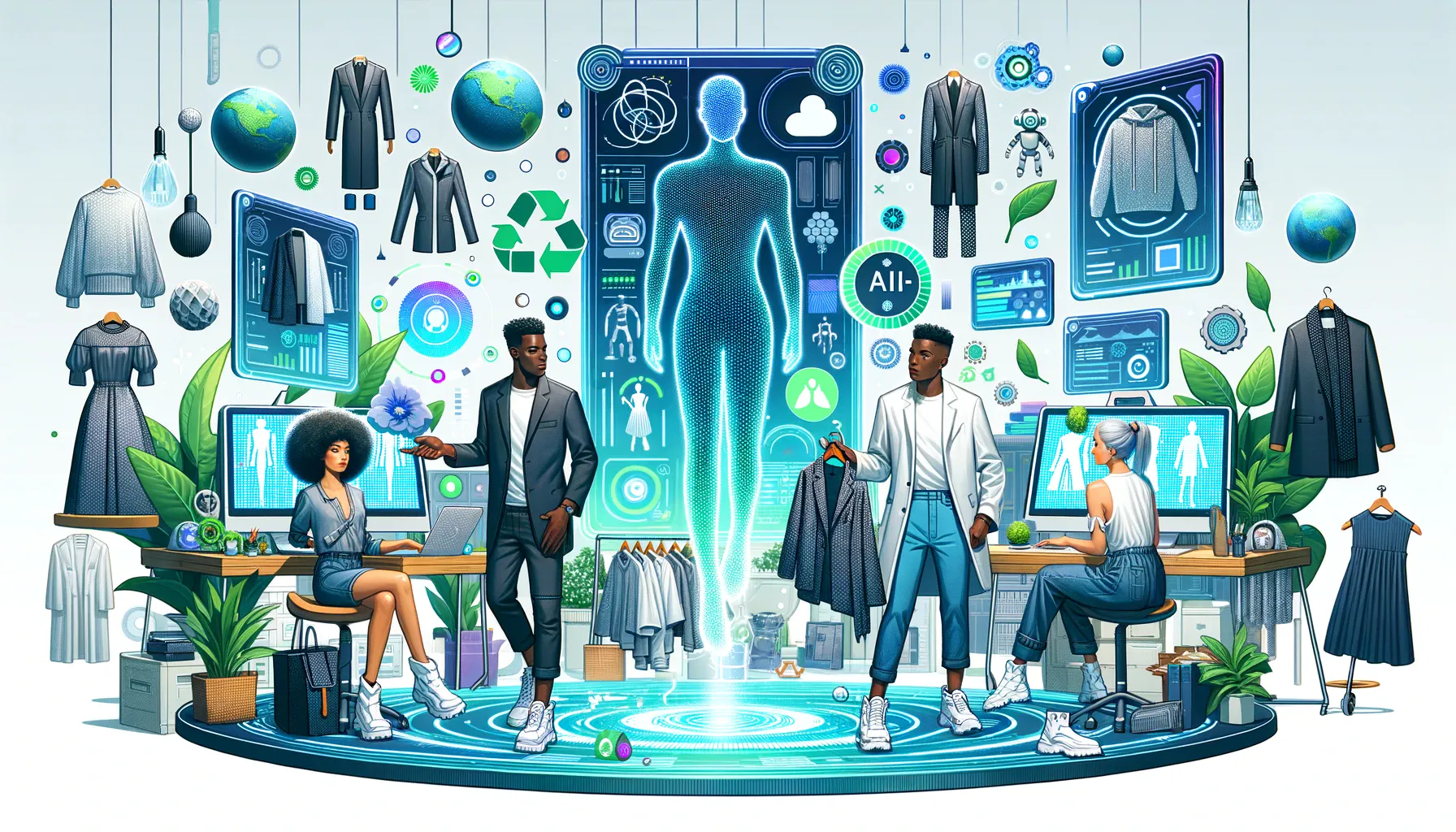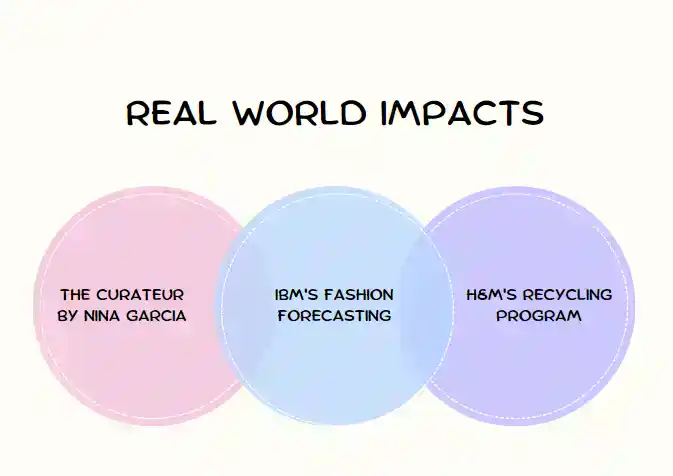Table of Contents
In the fast-paced and dynamic realm of AI in fashion, the task of staying at the forefront of emerging trends while simultaneously upholding sustainability standards has grown notably demanding. Nevertheless, the 21st century has introduced a novel partner to the AI in fashion industry, one that holds the potential to bring about a profound shift in how we predict style trends and tackle sustainability challenges: Artificial Intelligence (AI).
This article delves into the remarkable transformation that AI is driving within the fashion sector, with a particular focus on how it is augmenting style forecasting and bolstering sustainability efforts.

The Role of AI in Fashion
Artificial Intelligence, commonly known as AI, is a technology that simulates human intelligence to perform tasks that would typically require human intelligence. In the fashion industry, AI plays a pivotal role in enhancing various aspects of the design and manufacturing process.
AI in fashion leverages its ability to analyze vast datasets, predict emerging trends, and make recommendations that have a significant impact on the industry. Let’s delve deeper into how AI, specifically tailored for fashion, is contributing to the elevation of style forecasting and sustainability within the realm of AI in fashion.
Style Forecasting and AI
- Data-Driven Trend Analysis: AI algorithms can process vast amounts of data from sources like social media, fashion blogs, and e-commerce platforms. By analyzing this data, AI can identify emerging trends, helping AI in fashion brands stay ahead of the curve. For example, AI can track which colors, patterns, and styles are gaining popularity in real-time, enabling brands to adjust their collections accordingly.
- Personalized Recommendations: Online shopping experiences have been significantly enhanced by AI-driven recommendation systems. These systems consider individual preferences and purchase history to suggest AI in fashion items tailored to each customer’s unique style. This not only increases customer satisfaction but also reduces the likelihood of returns, promoting sustainability.
- Virtual Stylists: Some AI-powered applications act as virtual stylists, helping users put together outfits and discover new ways to wear existing pieces. For example, a person looking to buy tweed suits can virtually try on different colors, styles, sizes, etc, or if somebody needs a brand to make custom t-shirts can try different designs before making his purchase to make an informed decision. These tools can be invaluable for consumers and assist them in making the most of their wardrobes, reducing the need for constant new purchases.
Sustainability and AI
- Supply Chain Optimization: AI in fashion can optimize supply chain by predicting demand, reducing overproduction, and minimizing waste. By analyzing historical data and real-time variables, AI in fashion helps the brands manufacture only what is needed, minimizing the environmental impact.
- Material Innovation: AI can aid in the development of sustainable materials. For instance, it can predict the best combinations of materials for durability, comfort, and environmental friendliness, which is essential for the creation of eco-friendly clothing.
- Circular Fashion: AI can facilitate the concept of “circular fashion” by helping brands recycle and repurpose used clothing. By analyzing the quality and condition of old garments, AI can recommend appropriate recycling or upcycling options, reducing the amount of textile waste ending up in landfills.
Real-World Impact
The fusion of AI in fashion is not just theoretical; it is transforming the industry in tangible ways. Let’s take a look at some real-world examples of how AI is making a difference:

1. The curateur by Nina Garcia
Nina Garcia, the Creative Director of Marie Claire magazine, has launched “TheCurateur,” a subscription box service for luxury AI in fashion. AI is at the core of this platform, as it curates personalized selections based on individual style preferences and previous feedback. This application not only delivers a unique and enjoyable shopping experience but also promotes sustainability by avoiding the mass production of items that may not suit a customer’s taste.
2. IBM’s Fashion Forecasting
IBM Watson, IBM’s AI system, has used AI in fashion brands like Tommy Hilfiger and North Face to improve their forecasting accuracy. By analyzing historical sales data, customer reviews, and even weather reports, AI helps these brands anticipate the demand for specific products, thereby reducing overproduction and waste.
3. H&M’s Recycling Program
H&M, one of the world’s largest fashion retailers, has leveraged AI to promote sustainability. Their in-store AI system collects data on customer preferences and uses it to design new, more sustainable collections. Additionally, H&M has launched a recycling program where customers can drop off old clothing, which is then sorted and processed using AI algorithms for recycling or repurposing.
Challenges and Considerations
While AI in fashion holds significant promise for many fashion industries, there are challenges and ethical considerations to address:
Data Privacy: AI in fashion relies on the collection and analysis of extensive data, often obtained from customers, including their shopping habits, preferences, and even personal information. Ensuring data privacy and transparency is of paramount importance in the fashion industry’s AI-driven initiatives.
Customers need to have confidence that their data is being used responsibly and that their privacy is respected. Brands must implement robust data protection measures, including secure storage, encryption, and clear data usage policies. Maintaining trust through stringent data privacy practices is essential for the continued success of AI applications in the fashion industry.
Bias: AI algorithms used in fashion, like any other field, can inherit and perpetuate biases present in the data they are trained on. In the context of fashion, this can manifest as biases in style recommendations, color choices, or even body image standards. To mitigate these biases, it’s crucial to develop and use AI models that are fair and inclusive.
This involves not only diverse and unbiased training data but also ongoing monitoring and adjustments to ensure that the AI systems provide recommendations and insights that are free from prejudice. The fashion industry must strive to offer products and recommendations that cater to the diverse tastes and needs of their customers, irrespective of race, gender, or any other characteristic.
Environmental Impact: While AI in fashion brings immense benefits, it’s important to acknowledge the environmental impact of its implementation. AI infrastructure and data centers consume significant amounts of energy. Therefore, the fashion industry, as it integrates AI, should be environmentally conscious.
This means optimizing the energy efficiency of AI operations, exploring renewable energy sources for data centers, and considering the overall carbon footprint of AI implementations. Sustainability in AI infrastructure is a part of the broader goal of creating a sustainable fashion industry. AI can play a pivotal role in optimizing the supply chain, reducing waste, and promoting eco-friendly materials, but it should do so without exacerbating the industry’s environmental footprint.
In summary, while AI holds immense potential to transform the fashion industry, it must be harnessed responsibly. This entails safeguarding data privacy, addressing biases, and mitigating the environmental impact. By doing so, the fashion industry can truly elevate style forecasting and sustainability with the help of AI in the 21st century while building trust and maintaining ethical standards.
Conclusion
The line emphasizing “AI in fashion” underscores the profound collaboration between artificial intelligence and the fashion industry in the 21st century. This partnership is both thrilling and ecologically responsible, signifying a transformative shift in how AI is integrated into various aspects of the fashion business.
With the infusion of AI in fashion processes, novel opportunities emerge, particularly in the domains of style forecasting and sustainability. As the fashion industry continues its evolution, AI is poised to assume a progressively pivotal role, profoundly influencing trends and industry practices.
Fashion brands that wholeheartedly adopt AI technologies are poised to gain a distinct competitive advantage. They can anticipate and respond to evolving trends with remarkable precision, thereby reducing overproduction and curbing waste. Furthermore, their commitment to AI underscores their role in fostering a more sustainable and ethically responsible fashion industry.
With the support of AI, the fashion world is on the cusp of an exciting transformation, as it evolves into a landscape where style and environmental consciousness seamlessly coexist. This synergy not only promises to redefine the industry but also propel it to unprecedented heights in the 21st century.